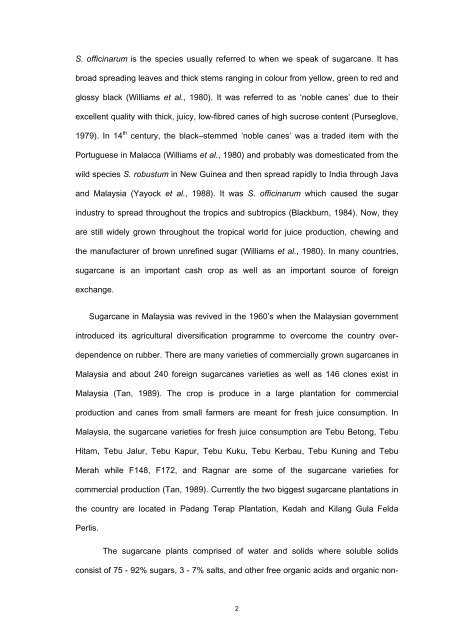pathogenicity and aethiology of fusarium species ... - ePrints@USM
pathogenicity and aethiology of fusarium species ... - ePrints@USM
pathogenicity and aethiology of fusarium species ... - ePrints@USM
Create successful ePaper yourself
Turn your PDF publications into a flip-book with our unique Google optimized e-Paper software.
S. <strong>of</strong>ficinarum is the <strong>species</strong> usually referred to when we speak <strong>of</strong> sugarcane. It has<br />
broad spreading leaves <strong>and</strong> thick stems ranging in colour from yellow, green to red <strong>and</strong><br />
glossy black (Williams et al., 1980). It was referred to as ‘noble canes’ due to their<br />
excellent quality with thick, juicy, low-fibred canes <strong>of</strong> high sucrose content (Purseglove,<br />
1979). In 14 th century, the black–stemmed ‘noble canes’ was a traded item with the<br />
Portuguese in Malacca (Williams et al., 1980) <strong>and</strong> probably was domesticated from the<br />
wild <strong>species</strong> S. robustum in New Guinea <strong>and</strong> then spread rapidly to India through Java<br />
<strong>and</strong> Malaysia (Yayock et al., 1988). It was S. <strong>of</strong>ficinarum which caused the sugar<br />
industry to spread throughout the tropics <strong>and</strong> subtropics (Blackburn, 1984). Now, they<br />
are still widely grown throughout the tropical world for juice production, chewing <strong>and</strong><br />
the manufacturer <strong>of</strong> brown unrefined sugar (Williams et al., 1980). In many countries,<br />
sugarcane is an important cash crop as well as an important source <strong>of</strong> foreign<br />
exchange.<br />
Sugarcane in Malaysia was revived in the 1960’s when the Malaysian government<br />
introduced its agricultural diversification programme to overcome the country over-<br />
dependence on rubber. There are many varieties <strong>of</strong> commercially grown sugarcanes in<br />
Malaysia <strong>and</strong> about 240 foreign sugarcanes varieties as well as 146 clones exist in<br />
Malaysia (Tan, 1989). The crop is produce in a large plantation for commercial<br />
production <strong>and</strong> canes from small farmers are meant for fresh juice consumption. In<br />
Malaysia, the sugarcane varieties for fresh juice consumption are Tebu Betong, Tebu<br />
Hitam, Tebu Jalur, Tebu Kapur, Tebu Kuku, Tebu Kerbau, Tebu Kuning <strong>and</strong> Tebu<br />
Merah while F148, F172, <strong>and</strong> Ragnar are some <strong>of</strong> the sugarcane varieties for<br />
commercial production (Tan, 1989). Currently the two biggest sugarcane plantations in<br />
the country are located in Padang Terap Plantation, Kedah <strong>and</strong> Kilang Gula Felda<br />
Perlis.<br />
The sugarcane plants comprised <strong>of</strong> water <strong>and</strong> solids where soluble solids<br />
consist <strong>of</strong> 75 - 92% sugars, 3 - 7% salts, <strong>and</strong> other free organic acids <strong>and</strong> organic non-<br />
2








![[Consumer Behaviour] - ePrints@USM](https://img.yumpu.com/21924816/1/184x260/consumer-behaviour-eprintsusm.jpg?quality=85)








